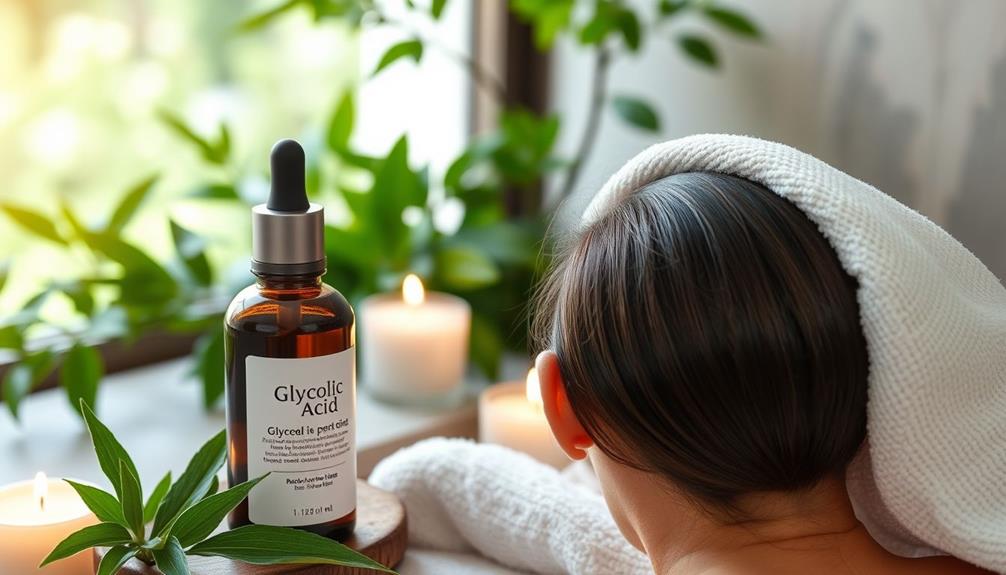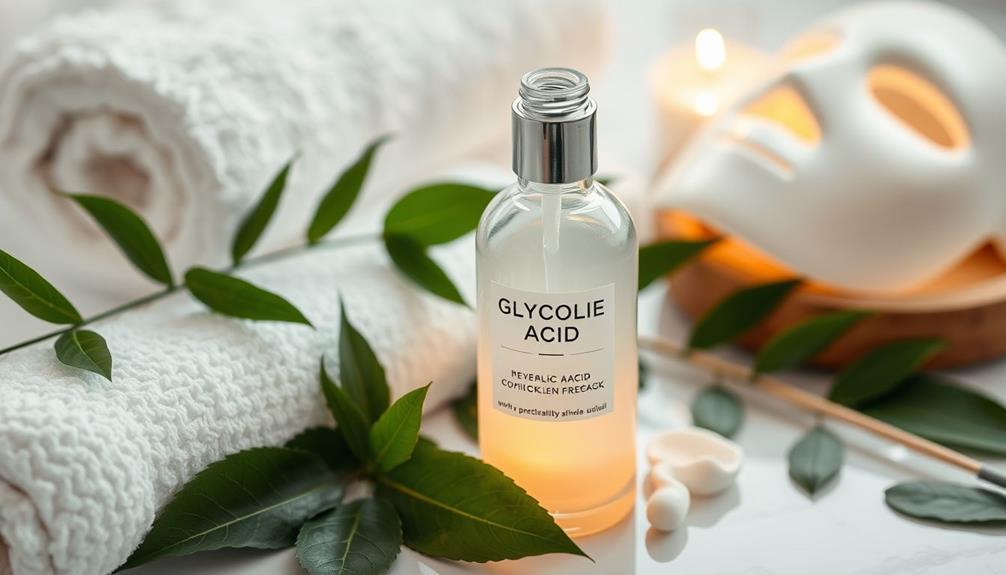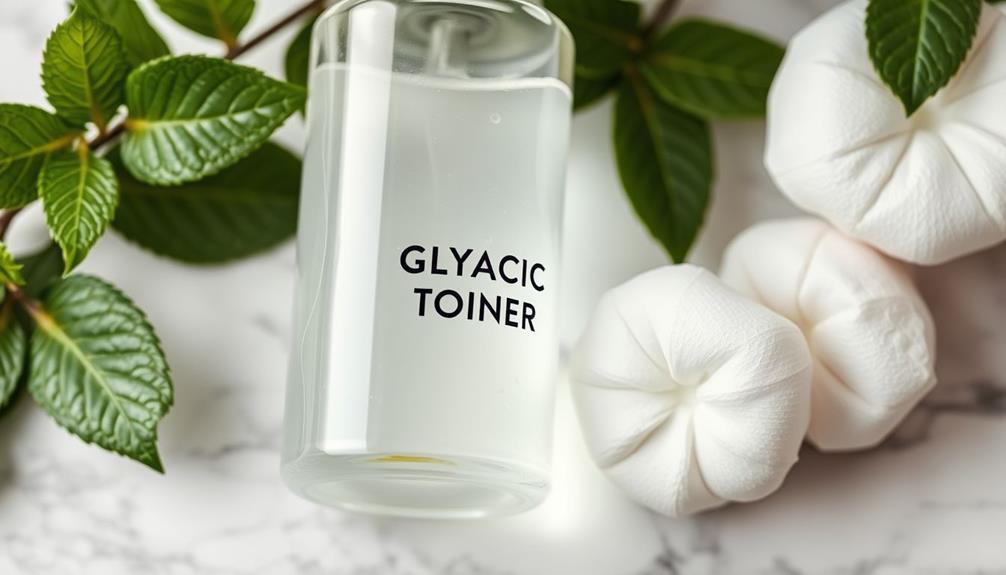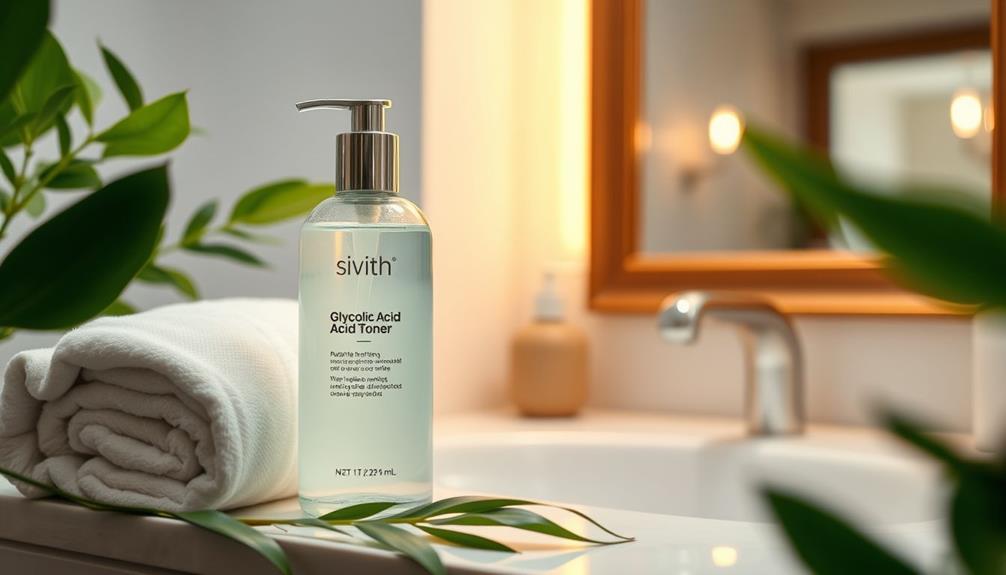Glycolic acid can be a beneficial asset for maintaining a healthy scalp. It eliminates dead skin cells, reduces dryness, and balances pH levels, promoting an optimal environment for hair growth. By increasing blood circulation, it improves the delivery of nutrients to hair follicles, while its antibacterial properties can prevent scalp acne. If you’re dealing with dandruff or product buildup, glycolic acid may provide relief. It is important to start with a lower concentration and use proper application techniques for optimal results. You can explore additional methods for enhancing scalp health with expert advice and effective alternatives.
Key Takeaways
- Glycolic acid exfoliates dead skin cells, reducing dryness and flakiness for a healthier scalp environment.
- It stimulates blood circulation, enhancing nutrient delivery to hair follicles and promoting hair growth.
- The acid balances scalp pH, aiding moisture retention and preventing irritation for improved hydration.
- Glycolic acid possesses antibacterial properties that help prevent and treat scalp acne and irritation.
What Is Glycolic Acid?

Glycolic acid, an alpha-hydroxy acid derived from sugarcane, penetrates deeply into the scalp to exfoliate and rejuvenate your skin. Its small molecular size allows it to effectively reach the deeper layers, making it a powerful ingredient in scalp care.
When combined with essential oils for hair growth, glycolic acid can enhance hair follicle stimulation and reduce hair thinning. You'll find that glycolic acid's exfoliating properties are essential for removing dead skin cells, which can lead to a healthier scalp environment.
By loosening and dissolving dry skin patches and dandruff, glycolic acid enhances the effectiveness of your regular shampooing routine. When you incorporate it into your scalp care regimen, you're not just addressing surface issues; you're promoting overall scalp health. This is especially important if you struggle with persistent dandruff or dry patches.
Typically, you'll find glycolic acid products formulated with concentrations ranging from 5% to 10%. It's usually recommended to use these products once or twice a week to prevent irritation.
With consistent use, you'll likely notice a smoother scalp texture and a reduction in the buildup of dead skin. Fundamentally, glycolic acid serves as a significant ally in enhancing your scalp's health and vitality.
Benefits for Scalp Health

When incorporated into your scalp care routine, glycolic acid offers numerous benefits that contribute to a healthier scalp and enhanced hair growth.
As an effective exfoliating agent, glycolic acid removes dead skin cells and excess sebum, creating an ideal environment for your hair follicles. This exfoliation not only clears away buildup but also helps reduce dryness and flakiness, improving overall scalp health. Regular scalp care, including effective exfoliation, is vital for maintaining a balanced environment for hair growth, similar to the importance of proper nutrition for overall health regular vet check-ups.
Moreover, glycolic acid boasts antibacterial properties that can prevent and treat scalp acne, ensuring a cleaner surface. By balancing the scalp's pH levels, it minimizes irritation and supports the natural barrier function, which can lead to decreased dandruff.
Regular use of glycolic acid can also stimulate blood circulation in your scalp, promoting hair growth by enhancing nutrient delivery to the hair follicles.
Incorporating glycolic acid into your regimen can greatly elevate your scalp health, making it an essential ingredient for those seeking healthier hair. With its hydrating effects and ability to maintain a balanced environment, glycolic acid is a smart choice for anyone looking to improve their scalp care routine.
Mechanism of Action

When you use glycolic acid on your scalp, it actively exfoliates dead skin cells, promoting cell renewal for a fresher, healthier environment.
This process not only helps reduce dandruff but also balances pH levels, keeping your scalp hydrated.
Incorporating essential oils can further enhance scalp health by providing additional moisture and calming effects, allowing for a more holistic approach to hair care essential oils for stress relief.
Exfoliation and Cell Renewal
Exfoliating with glycolic acid works by breaking down the lipid bonds between dead skin cells, making it easier for them to slough off and reveal healthier skin underneath. This process of exfoliation greatly boosts cell turnover, allowing your scalp to shed old, lifeless skin more effectively.
As the dead skin cells are removed, you'll notice a reduction in buildup, which can lead to issues like dandruff and irritation. Incorporating mindful eating and hydration into your routine can further enhance scalp health and overall well-being, as a balanced diet supports skin health and resilience holistic lifestyle approach.
With regular use of glycolic acid, you're fundamentally creating an environment that promotes cell renewal. This means fresh, vibrant skin can surface more quickly, enhancing not just your scalp's health but also the overall texture and appearance.
As dead skin cells are diminished, the absorption of other beneficial hair care products improves, ensuring that active ingredients penetrate deeper for better results.
Moreover, an accelerated cell turnover helps maintain a balanced scalp environment, essential for preventing common scalp conditions. By incorporating glycolic acid into your routine, you're not just exfoliating; you're laying down a healthier foundation for hair growth and overall scalp wellness.
Hydration and Ph Balance
Maintaining hydration and a balanced pH is essential for a healthy scalp, and glycolic acid plays a key role in achieving this by restoring the scalp's natural acidity.
By helping to maintain the scalp's pH balance, glycolic acid prevents dryness and irritation, creating an ideal environment for scalp health.
Understanding the significance of sustainable practices in beauty products can enhance your approach to scalp care, especially when considering sustainable harvesting methods for wild plants.
Its exfoliating properties effectively remove dead skin cells and excess sebum, which allows for better absorption of hydrating ingredients.
This increased absorption directly boosts moisture levels in your scalp, reducing issues like flakiness and itchiness.
When your scalp is well-hydrated, you'll experience improved comfort and overall health.
Glycolic acid also aids in moisture retention, ensuring that other hydrating agents penetrate your scalp more effectively.
This means your scalp remains adequately moisturized and less prone to dryness.
Regular use of glycolic acid can transform your scalp's microenvironment, promoting ideal hydration and balance.
Incorporating glycolic acid into your hair care routine can lead to healthier scalp conditions, which is essential for optimal hair growth and well-being.
Make it a part of your regimen to enjoy the benefits of enhanced hydration and balanced pH for improved scalp health.
Application Techniques

To effectively apply glycolic acid for scalp health, choose a serum or toner with a 5-7% concentration and gently massage it into your scalp, leaving it on for 20-30 minutes before rinsing. This method enhances the exfoliating effects, making it a vital part of your scalp treatments.
Incorporating anti-inflammatory foods into your diet can also support scalp health by reducing inflammation and promoting overall well-being, as noted in gout management strategies. Start by cleansing your scalp gently to prepare it for better absorption of the glycolic acid.
Before you engage, conduct a patch test to verify you won't have any adverse reactions, especially if you have sensitive skin or existing scalp conditions. It's also important to limit the application of glycolic acid to once a week. This helps prevent irritation while maintaining a balanced scalp environment.
After rinsing, always follow up with a hydrating treatment to replenish moisture. Glycolic acid can strip away natural oils, so this step is essential for preventing dryness.
Recommended Concentrations

When choosing glycolic acid for scalp health, aim for a concentration between 5% and 10% to effectively promote exfoliation and minimize irritation.
If you're new to glycolic acid or have a sensitive scalp, starting with a lower concentration around 5% is advisable. This approach helps reduce the risk of adverse reactions while still providing benefits.
Using glycolic acid at the recommended concentrations not only enhances scalp health but also improves cell turnover and reduces buildup. This ultimately supports better hair growth and texture.
Many individuals find success with products like The Ordinary's glycolic acid toner, which features a 7% concentration, making it a popular choice for those looking to incorporate this ingredient into their scalp care routine.
While higher concentrations above 10% can be effective, they should be used cautiously and ideally under professional supervision. The increased likelihood of scalp irritation and sensitivity is a significant concern.
Risks and Precautions

Using glycolic acid carries certain risks that you should be aware of to guarantee safe and effective scalp treatment.
First, be cautious if you have sores, sensitive skin, or very dry conditions on your scalp. Using glycolic acid in these situations can lead to scalp irritation, which may manifest as redness and itchiness.
It's also important to note that prolonged exposure can increase your sensitivity to UV rays, raising the risk of sunburn, so consider applying it in the evening.
Before diving in, always perform a patch test on a small area of your scalp. This will help you identify any potential allergic reactions or sensitivities to the acid.
For safe usage, it's best to limit applications to once a week, especially if you have a sensitive scalp. Over-exfoliation can lead to further irritation and dryness, negating the positive effects you're aiming for.
By being mindful of these precautions, you can enjoy the benefits of glycolic acid while minimizing risks.
Alternatives to Glycolic Acid

There are several effective alternatives to glycolic acid that can help maintain scalp health without the risk of irritation.
Lactic acid, for instance, is a milder AHA that promotes gentle exfoliation and hydration, making it a great choice for those with sensitive skin.
If you're looking for a natural option, apple cider vinegar can balance your scalp's pH and eliminate product buildup.
Tea tree oil is another excellent alternative, offering antimicrobial properties that combat dandruff and scalp acne.
For those with oily scalps, salicylic acid effectively penetrates the follicles to clear excess oil, reducing dandruff in the process.
You might also consider natural oils like argan and jojoba oil. These oils provide moisture and nourishment to your scalp and hair without the potential downsides of chemical exfoliants.
Before trying any of these alternatives, it's wise to consult with a dermatologist, especially if you have a sensitive scalp or any pre-existing conditions.
They can help you determine which alternative is best for your unique scalp health needs.
Signs You Need Glycolic Acid

If you're struggling with persistent dandruff or dry patches on your scalp, it might be time to contemplate incorporating glycolic acid into your routine. This powerful ingredient aids in the exfoliation process, effectively dissolving dead skin and promoting a healthier scalp environment.
You should also consider glycolic acid if you experience scalp irritation or itchiness. Its antimicrobial properties can help combat fungal issues and reduce inflammation, providing much-needed relief.
Additionally, if you notice excessive product buildup that regular shampoos can't remove, glycolic acid can enhance cleansing efficacy by loosening and dissolving residue, making your hair feel lighter and cleaner.
A decrease in hair shine or texture is another sign you could benefit from glycolic acid. It improves hair quality by smoothing cuticles and enhancing overall hydration.
Expert Tips for Use

To achieve the best results with glycolic acid for your scalp, apply it directly to the affected areas and gently massage it in for ideal absorption. This technique guarantees that the exfoliating properties of glycolic acid effectively remove dead skin cells and promote a healthier scalp.
For superior results, leave the scalp treatment on for 20-30 minutes before rinsing it out. This allows the glycolic acid to penetrate deeply, enhancing hydration and overall scalp health.
It's best to limit your use of glycolic acid to once a week to prevent irritation or dryness, especially if you have sensitive skin. Always consider patch testing a small area before applying it more broadly.
Avoid using glycolic acid if you have open wounds, sores, or a very dry scalp, as this can lead to further irritation.
If you're unsure about how to incorporate glycolic acid into your routine or if you're undergoing other treatments, it's a good idea to consult with a dermatologist. They can provide personalized advice tailored to your specific scalp needs and help you maximize the benefits of this powerful ingredient.
Long-Term Scalp Care Strategies

Regularly incorporating glycolic acid into your scalp care routine can greatly enhance long-term scalp health and promote ideal hair growth. By exfoliating away dead skin cells, you create a clean environment for your hair to thrive.
To establish a successful routine, consider these key strategies:
- Exfoliate regularly with glycolic acid to maintain a balanced scalp.
- Hydrate with hyaluronic acid to boost moisture levels and prevent dryness.
- Use gentle, pH-balanced cleansers to avoid irritation and support your scalp's microbiome.
- Perform scalp massages to stimulate blood circulation, enhancing nutrient delivery to hair follicles.
Frequently Asked Questions
Does Glycolic Acid Help With Scalp Health?
Yes, glycolic acid can improve your scalp health. It exfoliates, removes dead skin, and prevents clogged follicles, which promotes better hair growth, hydration, and overall scalp balance when used regularly in appropriate concentrations.
How to Apply Glycolic Acid on Hair?
Imagine a revitalizing waterfall cascading over your scalp. To apply glycolic acid, massage a low-concentration serum into your scalp, leave it for 20-30 minutes, then rinse thoroughly to reveal renewed, healthy hair.
Does Glycolic Acid Help With Split Ends?
Glycolic acid won't directly fix split ends, but it can improve your scalp's health. By exfoliating and promoting better hair growth, it may lead to stronger strands, reducing the likelihood of future split ends.
Is Salicylic Acid or Glycolic Acid Better for Dandruff?
When it comes to dandruff, you've got to choose your weapon wisely. Salicylic acid's better for oily scalps, while glycolic acid works wonders for dry or sensitive ones. Pick what suits your scalp best!
Conclusion
Incorporating glycolic acid into your scalp care routine can feel like a revitalizing rain after a long drought, rejuvenating your scalp and promoting healthier hair growth.
As you gently massage it in, envision the dead skin cells melting away, leaving behind a vibrant, nourished landscape.
With consistent use and expert tips, your scalp can thrive, transforming into a lush, flourishing garden.
Embrace this journey, and watch your scalp health bloom like never before.










